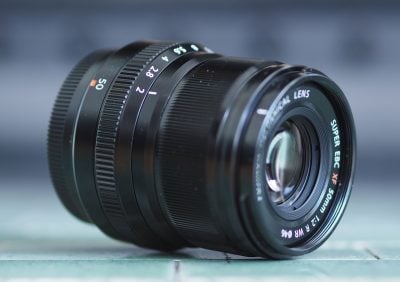Fujifilm XF 50mm f2 review
-
-
Written by Gordon Laing
In depth
The Fujifilm XF 50mm f2 is a short telephoto prime lens designed for Fujifilm’s X-series mirrorless cameras. Announced in January 2017, it’s actually the first X lens with an exact 50mm focal length, although joins two existing 56mm options in the series.
Mounted on an X body, the XF 50mm f2 delivers a 75mm equivalent field-of-view, providing short telephoto coverage that’s perfect for portraits, but also useful for slightly tighter than average urban and landscape shots. Meanwhile the fairly bright f2 focal ratio allows you to easily isolate a subject with a shallow depth-of-field effect.
In the Fuji catalogue, the closest rivals to the XF 50mm f2 are the twin XF 56mm f1.2 models. These deliver a fractionally longer focal length equivalent to 84mm, but crucially with a focal ratio that’s around one and a half stops brighter, allowing even shallower depth-of-field effects; the APD version additionally delivers further control over defocusing. The newer XF 50mm f2 fights back with a much smaller and lighter barrel, weather-proofing, quicker and quieter focusing, not to mention a price that’s roughly half of the 56mm f1.2 and as little as a third of the APD version. But how do the sharpness and rendering compare? To find out I tested the new XF 50mm f2 directly alongside the original XF 56mm f1.2 in a variety of conditions. Keep reading to find out which short telephoto lens will be the best for your Fujifilm body!
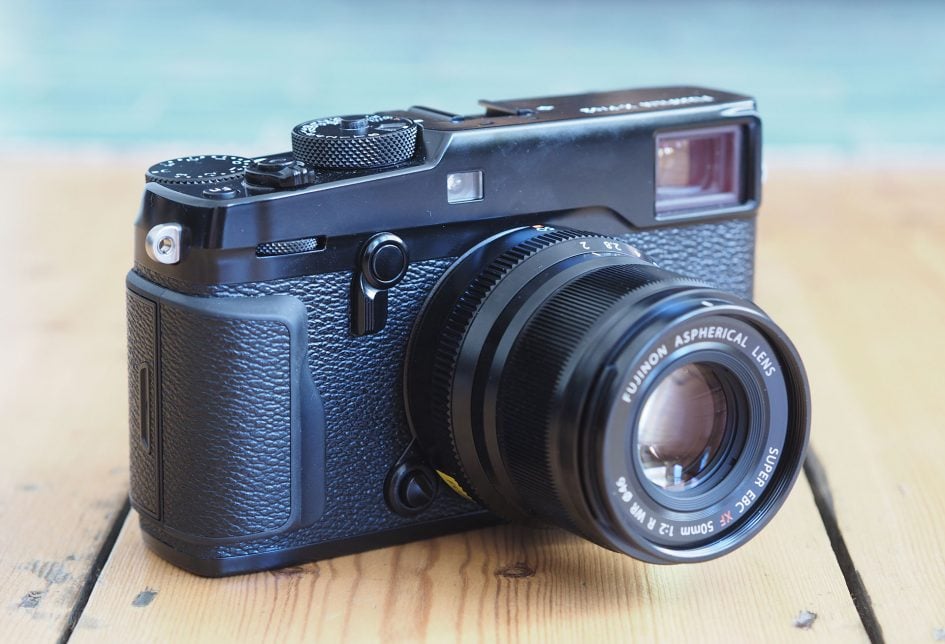
Fujifilm XF 50mm f2 design and build quality
The Fujifilm XF 50mm f2 becomes the third model in its compact, weather-sealed f2 series, following the XF 35mm f2 and XF 23mm f2 models. Like them, it shares a simple, slightly tapered profile designed to present the least obstruction in the corner of the optical viewfinder on the X-Pro bodies – although of course all X-series owners can appreciate the compact and lightweight form factor.
At its widest point by the lens mount, the XF 50mm f2 has a maximum diameter of 60mm, but again this tapers beyond the aperture ring to a little over 50mm by the time you reach the 46mm filter thread at the end. Meanwhile the lens barrel measures 60mm in length, making it the longest in the f2 threesome so far, albeit still compact compared to most of its alternatives.
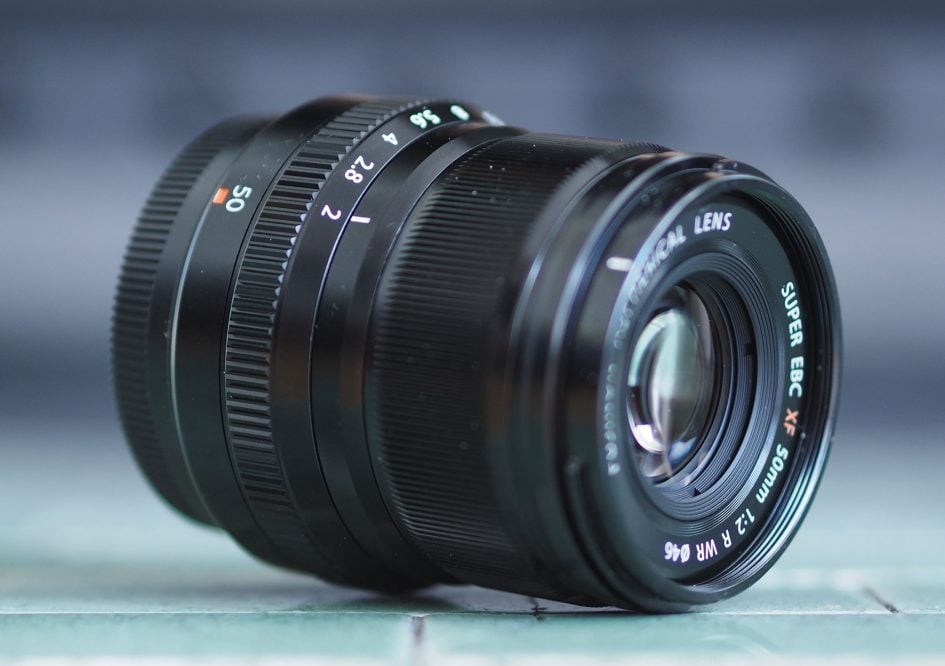
The closest rival to the XF 50mm f2 in the X-range is arguably the XF 56mm f1.2, a lens with a slightly longer focal length and a comfortably larger aperture. Unlike the XF 50mm f2, it unsurprisingly grows in diameter as you move towards the front elements, starting at around 55mm at the lens mount and growing to 73mm around the manual focusing ring. The filter size is understandably wider at 62mm, and the barrel itself longer too at 70mm; the XF 56mm f1.2 is also double the weight at 405g vs 200g for the XF 50mm f2.
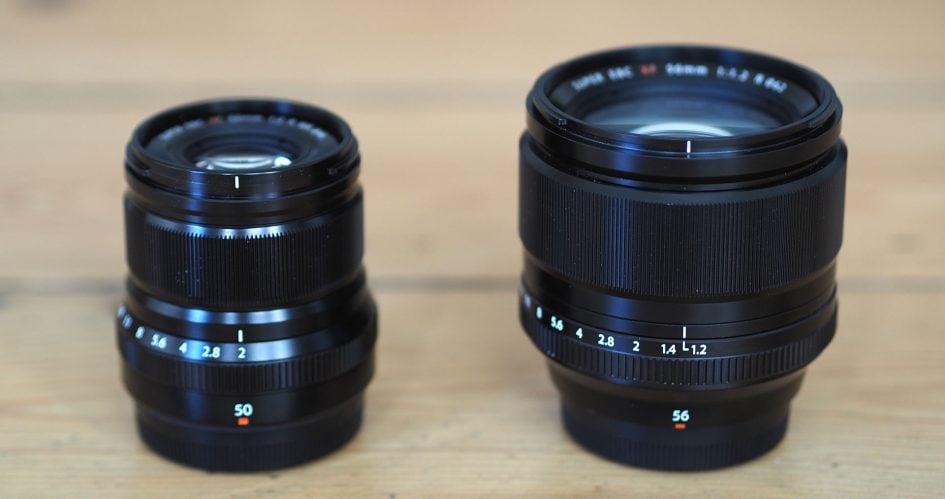
Above left: Fujifilm XF 50mm f2. Above right: Fujifilm XF 56mm f1.2.
I’ve pictured the XF 50mm f2 alongside the XF 56mm f1.2 above, without their lens hoods, and it’s clear how much heftier the latter is in comparison – it’s not so much the length you notice but the girth and the weight. When I was testing these lenses, I also had the XF 23mm f2 and XF 23mm f1.4 in my bag, and the difference in heft between the f2 models and the earlier brighter aperture alternatives was quite striking. If you’re happy with the f2 focal ratio, you really can build a comfortably smaller and lighter kit with these new lenses, while also enjoying faster focusing, closer focusing and weather-sealing.
Both the XF 50mm f2 and XF 56mm f1.2 are supplied with lens hoods, the latter’s being much more substantial and greatly increasing its size when fitted. Luckily both can be reversed over their respective lens barrels for transportation. I’ve pictured them both below.
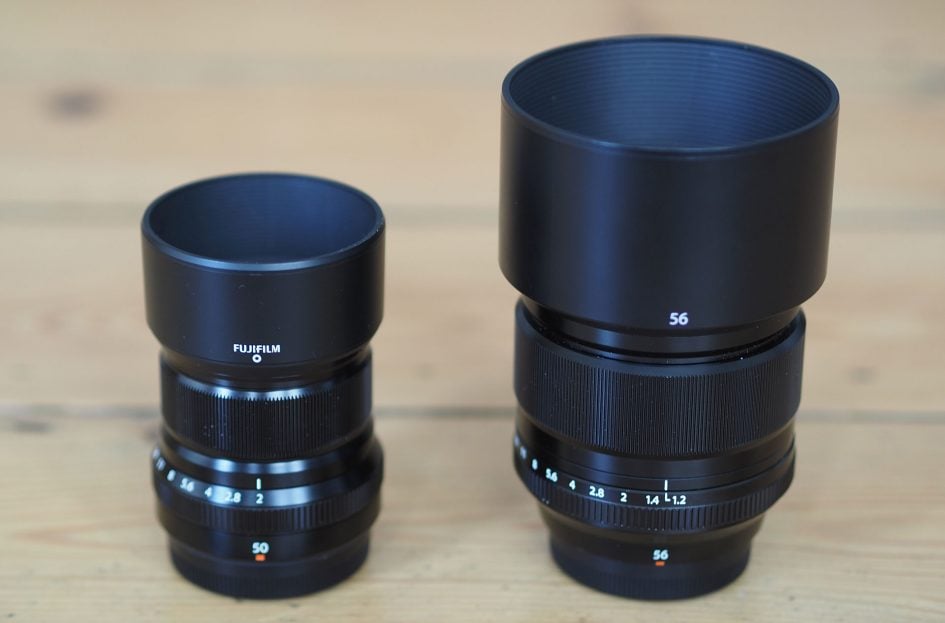
Above left: Fujifilm XF 50mm f2. Above right: Fujifilm XF 56mm f1.2. Both with supplied lens hoods.
Like the previous tapered f2 models, the XF 50mm f2 has a simple design with a labelled aperture ring close to the lens mount (f2 to f16 in third stop clicks followed by an A position) and a smooth manual focusing ring towards the end. Obviously the XF 56mm f1.2’s aperture ring includes more positions to accommodate the brighter focal ratio, but in terms of mechanics they feel similar.
Again like the previous f2 models, the XF 50mm f2 enjoys the benefit of weather-sealing with a rubber grommet around the lens mount – and presumably greater sealing around the barrel itself, although Fujifilm doesn’t go into details. Either way, the rubber grommet is a clear difference with the XF 56mm f1.2 which lacks any kind of official sealing. I was always disappointed by its absence on the 56mm, not to mention other early Fujifilm lenses, and while I’m pleased to find all the new models enjoy sealing, I remain frustrated the older ones did not.
In terms of autofocusing (tested on an X-Pro2 body), the XF 50mm f2 is fairly swift and while slightly audible in quiet conditions, rarely obtrusive. In comparison the XF 56mm f1.2 feels slower, less confident and a little louder too – not deal-breakingly so in any regard, but anyone shooting candids or street will appreciate the extra speed of the newer XF 50mm f2.
In terms of manual focusing, like all Fujifilm lenses, the XF 50mm f2 employs a fly-by-wire system whereupon turning the freely-spinning focusing ring instructs the AF motor to adjust the mechanism. It can feel slightly detached if you’re coming from a completely mechanically-linked system, but if you’re familiar with the Fujifilm system you’ll be right at home. I should note the XF 50mm f2, like the XF 56mm f1.2, does not have a focusing ring that pulls back to reveal focus distance markings and hard ends; this feature is only provided on a handful of Fujifilm lenses, like the XF 23mm f1.4.
Fujifilm XF 50mm f2 optical construction
In terms of optical construction, the Fujifilm XF 50mm f2 employs nine elements in seven groups, including one aspherical ED element. The maximum focal ratio is f2, the aperture employs nine rounded blades and the closest focusing distance is 39cm for a reproduction of 0.15x. Like all of Fujifilm’s prime lenses to date, the XF 50mm f2 does not offer optical stabilisation, so since none of the bodies at the time of writing offered built-in stabilisation either, you’ll need to be aware of minimum shutter speeds to avoid camera-shake; videographers wanting to iron-out any wobbles will need to use third party stabilising rigs.
The closest lens in Fuji’s catalogue, at least in terms of focal length, is the older XF 56mm f1.2. This employs 11 elements in eight groups including one aspherical and two extra low dispersion elements, sports a maximum focal ratio of f1.2, uses seven rounded aperture blades, and has a closest focusing distance of 70cm for a maximum reproduction of 0.09x. Again there’s no optical stabilisation, although Fujifilm does offer an APD version of the XF 56mm f1.2 lens which delivers a softer rendering style to out-of-focus areas which some portrait photographers will prefer.
And it will be portrait photographers who are primarily looking at lenses of this focal length: mounted on an X-series mirrorless body with an APSC sensor, the XF 50mm f2 and XF 56mm f1.2 lenses deliver effective focal lengths of 75mm and 84mm respectively. These are classed as short telephotos and a classic choice for close-range portrait shots. That said, I’m also fond of using this length for picking out slightly tighter views on landscapes and urban views. Here’s a couple of examples of their relative coverage with the XF 50mm f2 in the left column and the XF 56mm f1.2 in the right. Obviously the XF 50mm f2 delivers a slightly wider field-of-view, but I wouldn’t choose either of them based on focal length alone as there’s not much in it and much more important things to compare them on.

Above left: XF 50mm f2. Above right: XF 56mm f1.2. Coverage from same position.

Above left: XF 50mm f2. Above right: XF 56mm f1.2. Coverage from same position.
The greatest difference between the XF 50mm f2 and XF 56mm f1.2 in terms of optics is of course their maximum focal ratio. Opened-up, the XF 56mm f1.2 gathers over twice the light, allowing you to use shutter speeds over twice as fast, or ISOs less than half the speed. This can be useful for avoiding camera-shake without having to boost the ISO as far, but more importantly a brighter focal ratio allows you to achieve shallower depth-of-field effects. The greater potential for blurring out-of-focus areas on the XF 56mm f1.2 is also accentuated a little further by its slightly longer focal length, although as you’ll discover in a moment, the closest focusing distance also plays an important role.
So what difference can you expect between the XF 50mm f2 and the XF 56mm f1.2 in practice? I’ll start with a portrait shot at their maximum apertures, with the XF 50mm f2 version taken a tad closer to roughly match the subject size on the frame.
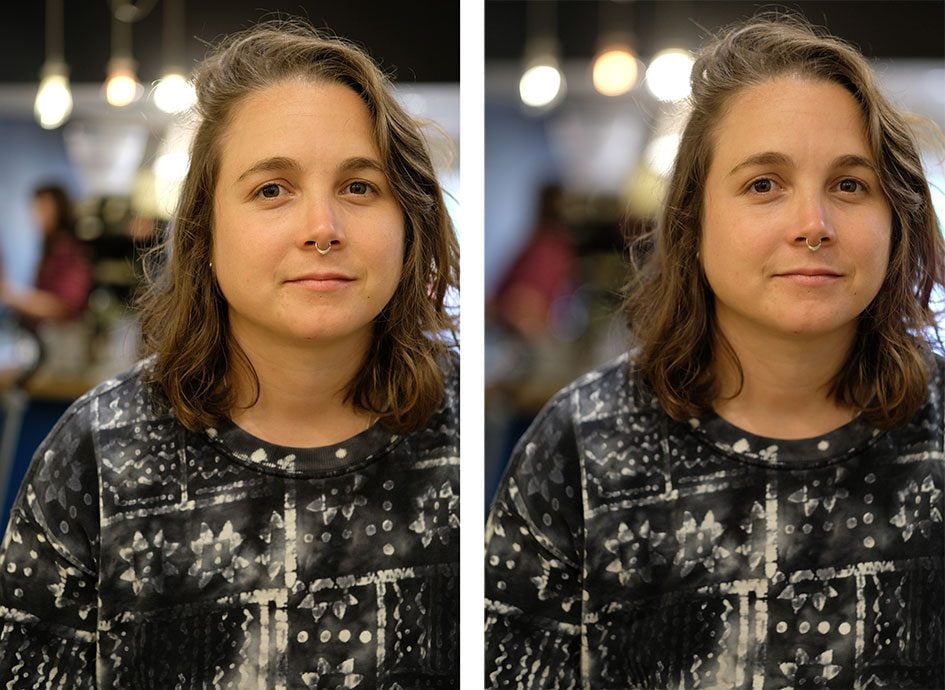
Above left: XF 50mm f2 at f2. Above right: XF 56mm f1.2 at f1.2. Distance adjusted to match subject size.
In the portrait shot above, it’s clear how both lenses are capable of delivering shallow depth-of-field effects even when the background’s only a couple of meters distant, but it’s also clear how the XF 56mm f1.2 on the right has more easily obliterated it. Look at the person in the red top, the clear funnel for the coffee grinder and the machinery and tabletop below it – they may be blurred on the XF 50mm f2, but still recognisable, whereas the larger aperture on the XF 56mm f1.2 has rendered them much less distinct. The shape of the lights are also more recognisable on the XF 50mm f2 at this distance, whereas they’ve been rendered into larger bokeh blobs on the XF 56mm f1.2. In isolation I’ve often felt the XF 56mm f1.2 can be a little precise on its blurred rendering, but here it’s looking quite creamy in comparison. That’s not to say the XF 50mm f2 is looking bad, but if you want the maximum blurring, largest bokeh blobs and smoothest rendering, especially when the background isn’t all that distant, then the XF 56mm f1.2 is the lens to aim for.
Shallow depth-of-field effects can also be beneficial on close-up shots, and this is where the closer focusing distance of the XF 50mm f2 can work to its advantage. More about that in a moment, but first here’s a composition where I could again match the subject size with both lenses. Here the beer bottle (a Vleteren for Belgian beer lovers out there) was close to the minimum focusing distance of the XF 56mm f1.2, but easily within range of the XF 50mm f2; as before, I positioned the camera a tad closer for the XF 50mm f2 shot to roughly match the subject size on the frame, hence the slightly different perspective as a result.
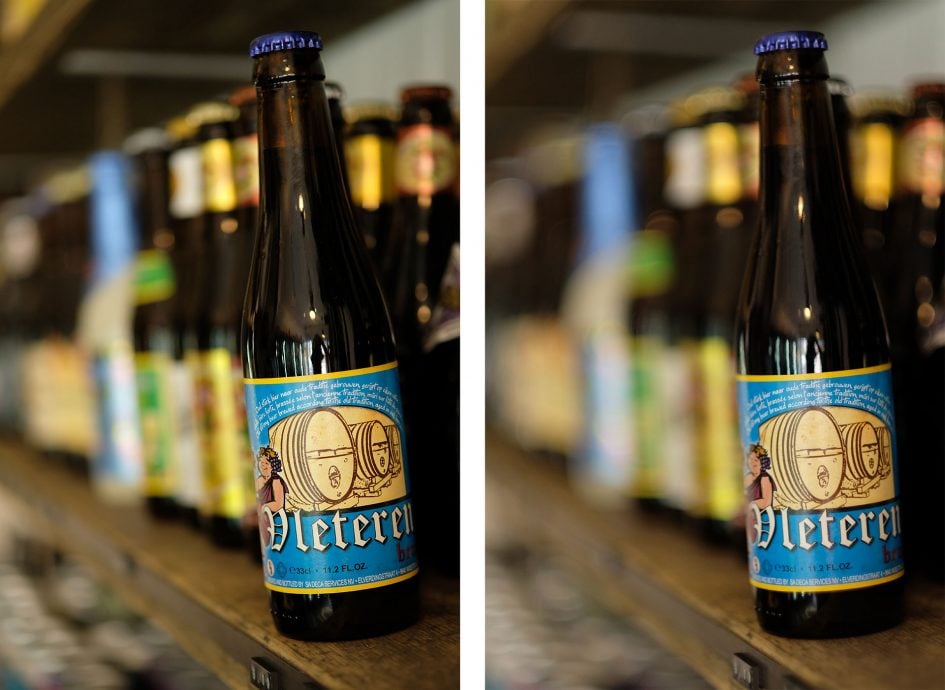
Above left: XF 50mm f2 at f2. Above right: XF 56mm f1.2 at f1.2. Distance adjusted to match subject size.
Once again both lenses have delivered attractive blurring effects without any harsh edges, but again the larger aperture of the XF 56mm f1.2 above right is noticeably blurrier and creamier. Even the bottles immediately behind the main subject are nicely blurred, and by the time you reach the Delerium bottle in pale yellow in the middle distance, the difference in their rendering capabilities is quite obvious. But once again I have no complaints about the XF 50mm f2, it’s just that the XF 56mm f1.2 is unsurprisingly more capable at shallower depth-of-field effects.
Moving onto bokeh-balls, I shot an ornamental tree with some LED fairy lamps behind it. Note the LEDs had a rectangular shape, so don’t look for perfectly circular blobs here. Like the previous example with the beer bottles, I focused close to the minimum distance of the XF 56mm f1.2, then repositioned slightly so the XF 50mm f2 roughly matched the subject size on the frame.
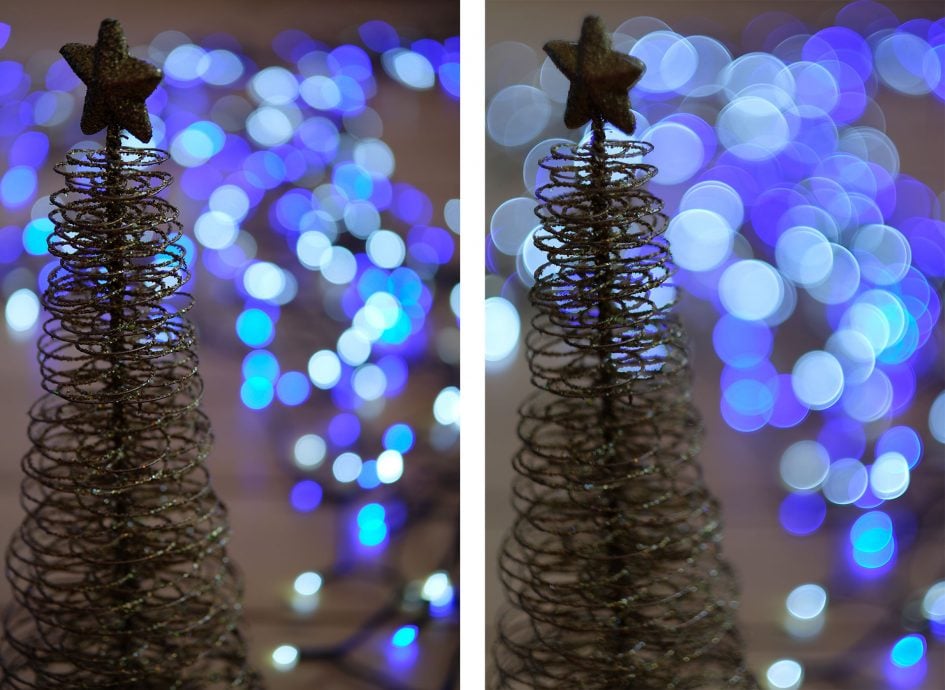
Above left: XF 50mm f2 at f2. Above right: XF 56mm f1.2 at f1.2. Distance adjusted to match subject size.
In the example above, both lenses deliver attractive bokeh blobs with no onion-ringing, typically turning to cat’s eye shapes towards the corners, but it’s clear how the XF 56mm f1.2, above right, is delivering larger bokeh blobs than the XF 50mm f2 on the left. That said, the XF 56mm f1.2 is rendering its blobs with quite clear outlines in comparison which may or may not be to your taste. Once again though, at least there’s no onion-ring patterns within the blobs on either.
So far, outlining on the blobs aside, a decisive lead for the XF 56mm f1.2 in terms of rendering and potential for blurring, but this isn’t the end of the story. As noted earlier, the XF 50mm f2 enjoys a comfortably closer minimum focusing distance compared to the XF 56mm f1.2 of 39cm vs 70cm – that’s almost twice as close, so even with the slightly shorter focal length, you can produce larger magnifications with the XF 50mm f2. In turn the closer focusing accentuates a shallow depth-of-field, so to illustrate this in practice I reshot the ornament at the closest focusing distance of each lens.
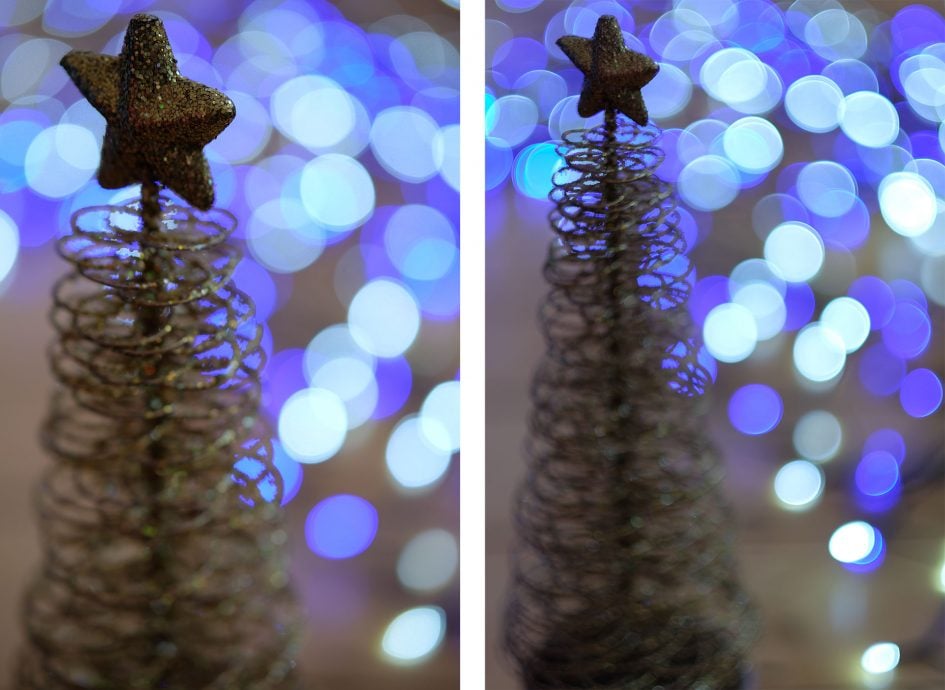
Above left: XF 50mm f2 at f2. Above right: XF 56mm f1.2 at f1.2. At closest focusing distance of each lens.
To confirm, you’re looking at the XF 50mm f2 on the left above, alongside the XF 56mm f1.2 on the right, both at the maximum apertures. It’s clear to see here that the closer focusing of the XF 50mm f2 has trumped the brighter aperture of the XF 56mm f1.2 in terms of bokeh blobs at the minimum focusing distance. The blobs are larger while continuing to lack the more obvious outlining of the XF 56mm f1.2’s blobs on the right. Again neither exhibits undesirable onion ringing patterns.
So while the XF 56mm f1.2 can deliver greater blurring from the same subject distance, it can be beaten at the closest focusing distance. Indeed for me, the closest focusing distance of 70cm is a limiting factor of the XF 56mm f1.2, reducing its usefulness for product or food photography. I know it’s a trivial example, but I couldn’t hold an object at arm’s length and focus on it using the XF 56mm f1.2 and the camera’s viewfinder to my eye. Similarly when shooting product shots, I had to position the subject sufficiently far for it to be in focus that I couldn’t easily reach out to make adjustments while still viewing the camera’s screen. This won’t affect portrait photographers – unless they’re wanting the eye to dominate the frame of course – but it’s something to be aware of for anyone shooting products or smaller subjects at close range.
As a final example to illustrate their maximum magnification, I shot a ruler at their closest focusing distances. As you can see below, the XF 50mm f2 on the left can reproduce an object measuring as little as 143mm across the frame, compared to 245mm for the XF 56mm on the right. It’s a significant difference.

Above left: XF 50mm f2. Above right: XF 56mm f1.2. At closest focusing distance of each lens.
Moving on, the aperture system does more than just define the potential for blurring. Close it right down to the minimum values and diffraction can render point sources of light into spiked shapes. The number of spikes and their shape is defined by the aperture’s opening and the blades which form its shape. The XF 50mm f2 employs nine blades compared to seven on the XF 56mm f1.2; these in turn mean 18 diffraction spikes on the XF 50mm f2 compared to 14 on the XF 56mm f1.2, but how do they look in practice?
To find out I shot two compositions at dusk which included some bright, distant lights. First a view of The City of London from the South Bank. Here’s the full composition below and below that I’ve cropped and enlarged a portion from just below right of centre which featured the best-defined diffraction spikes. I shot both lenses at their minimum apertures of f16.
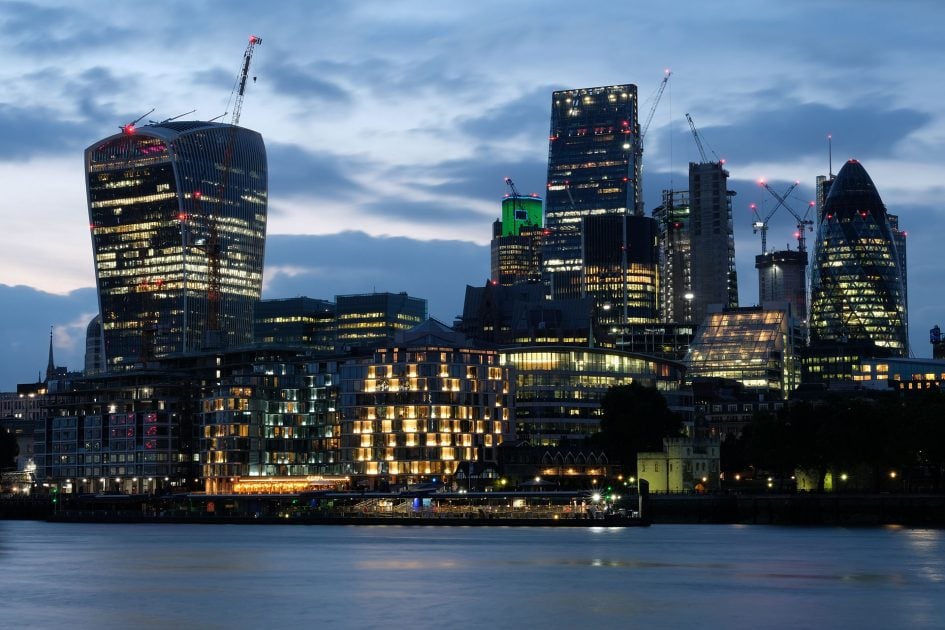
Above: Fujifilm XF 50mm f2 at f16, complete image. Crops below from each lens.

Above left: XF 50mm f2 at f16. Above right: XF 56mm f1.2 at f16. 100% crop from image above.
In the crop above you’re looking at the XF 50mm f2 on the left and the XF 56mm f1.2 on the right; since the shooting distance remained the same, the slightly longer focal length of the latter lens has delivered a slightly tighter view and crop as a result.
As you can see, the XF 50mm f2 and XF 56mm f1.2 have delivered 18 and 14 spikes respectively as expected from their nine and seven aperture blades. But in the crop above it’s clear how much better-defined the spikes are from the XF 56mm f1.2. This is most likely down to the actual shape of the blades themselves, and when it comes to rendering blobs at different apertures, the XF 50mm f2 may be less geometrical. But when it comes to diffraction spikes, the XF 56mm f1.2 is clearly superior in my first example.
For a second example, I photographed London’s Tower Bridge, again with both lenses from the same distance and closed to f16. Here’s the full view, followed again by crops of the best-defined spikes.
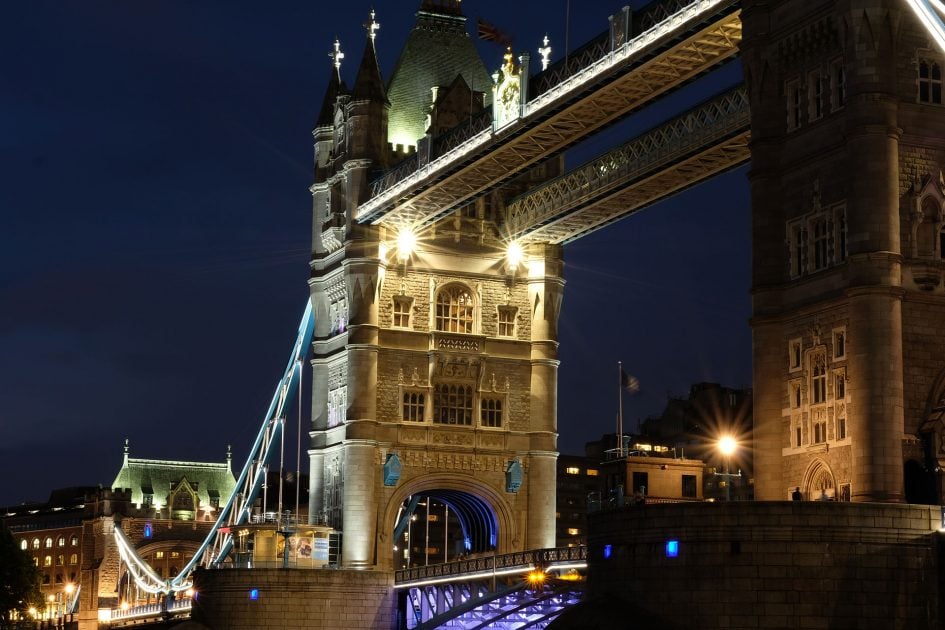
Above: Fujifilm XF 50mm f2 at f16. Complete view. Crops from each lens below.
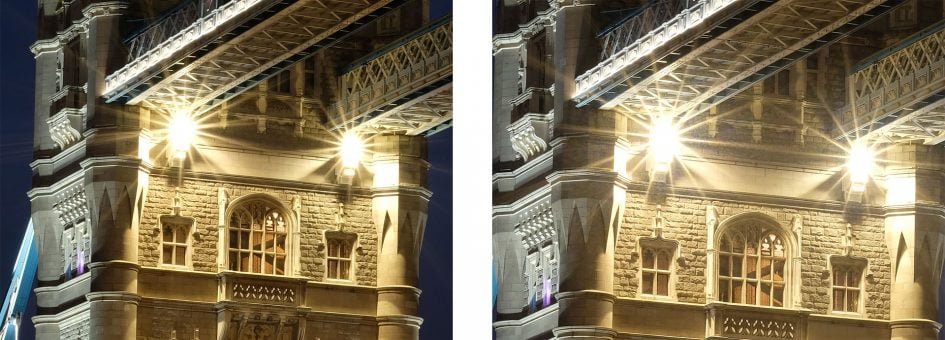
Above left: XF 50mm f2 at f16. Above right: XF 56mm f1.2 at f16. Crops from image above.
With a brighter light at closer range, the XF 50mm f2, on the left above, delivers better-looking diffraction spikes than previously, but for me it’s the XF 56mm f1.2 on the right above that’s best of all, with finer, sharper and better-defined spikes.
And finally for my tests on this page a quick look at geometry and vignetting. As before the XF 50mm f2 is on the left and the XF 56mm f1.2 on the right; for the geometry, both were set to f5.6, while for the vignetting, both were set to their maximum apertures and focused to infinity. In this instance I’ve used out-of-camera JPEGs with the default corrections.

Above left: XF 50mm f2. Above right: XF 56mm f1.2. Geometric distortion.

Above left: XF 50mm f2 at f2. Above right: XF 56mm f1.2 at f1.2. Vignetting at infinity.
Both lenses are pretty well-behaved in both regards, at least for the out-of-camera JPEGs. The only thing to note is a minor difference in geometry, with a small pincushion from the XF 50mm f2 and a small barrel from the XF 56mm f1.2 – certainly nothing to be worried about.
Keep reading for my final verdict or if you’d like to delve deeper, check out my outdoor resolution comparison on the quality page, or my sample images page using the tabs above.
Fujifilm XF 50mm f2 final verdict
Fujifilm’s XF 50mm f2 is a compelling alternative to the XF 56mm f1.2 for anyone who wants a short telephoto lens for portraits or details. Most obviously it’s comfortably smaller and lighter than the XF 56mm and around half the price too. It has quicker, quieter and much closer focusing, making it preferred for spontaneous shots, movies and product photography, and it enjoys the benefits of weather sealing too. X-Pro owners will also appreciate the narrower tapered barrel that presents less of an obstruction when using the optical viewfinder. Unsurprisingly the XF 56mm f1.2 remains the King if you want the shallowest depth-of-field at portrait distances, and its rendering and diffraction spikes are more attractive too, but the size, price and overall strong performance from the XF 50mm f2 will see it happily adopted by many X-series owners; I can also see an argument for owning both it and the XF 56mm f1.2.
Check prices on the Fujifilm XF 50mm f2 at Amazon, B&H, Adorama, or Wex. Alternatively get yourself a copy of my In Camera book or treat me to a coffee! Thanks!
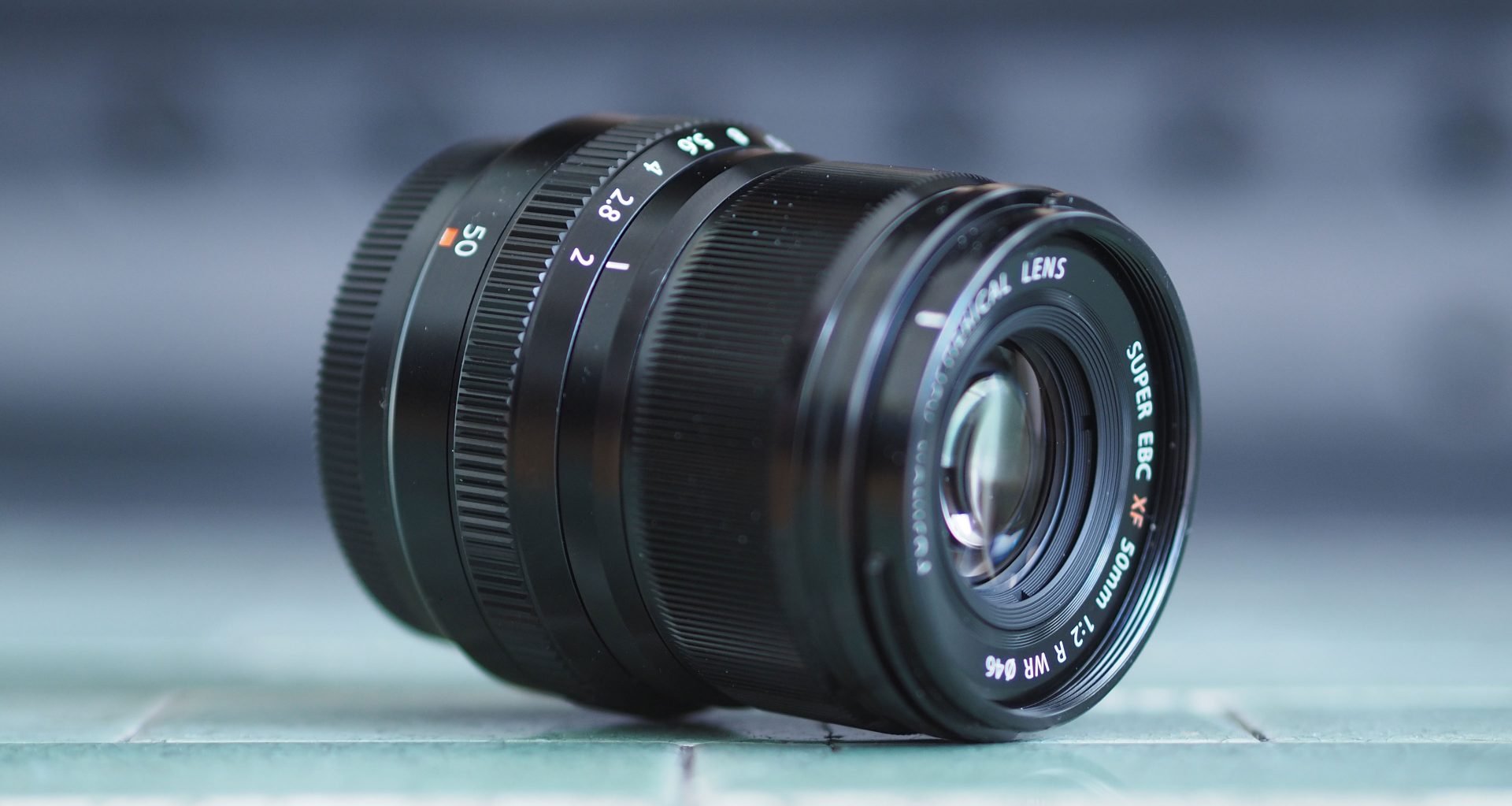
 Fujifilm's XF 50mm f2 is a compelling alternative to the XF 56mm f1.2 for anyone who wants a short telephoto lens for portraits or details. Most obviously it's comfortably smaller and lighter than the XF 56mm and around half the price too. It has quicker, quieter and much closer focusing, making it preferred for spontaneous shots, movies and product photography, and it enjoys the benefits of weather sealing too. X-Pro owners will also appreciate the narrower tapered barrel that presents less of an obstruction when using the optical viewfinder. Unsurprisingly the XF 56mm f1.2 remains the King if you want the shallowest depth-of-field at portrait distances, and its rendering and diffraction spikes are more attractive too, but the size, price and overall strong performance from the XF 50mm f2 will see it happily adopted by many X-series owners; I can also see an argument for owning both it and the XF 56mm f1.2.
Fujifilm's XF 50mm f2 is a compelling alternative to the XF 56mm f1.2 for anyone who wants a short telephoto lens for portraits or details. Most obviously it's comfortably smaller and lighter than the XF 56mm and around half the price too. It has quicker, quieter and much closer focusing, making it preferred for spontaneous shots, movies and product photography, and it enjoys the benefits of weather sealing too. X-Pro owners will also appreciate the narrower tapered barrel that presents less of an obstruction when using the optical viewfinder. Unsurprisingly the XF 56mm f1.2 remains the King if you want the shallowest depth-of-field at portrait distances, and its rendering and diffraction spikes are more attractive too, but the size, price and overall strong performance from the XF 50mm f2 will see it happily adopted by many X-series owners; I can also see an argument for owning both it and the XF 56mm f1.2.



